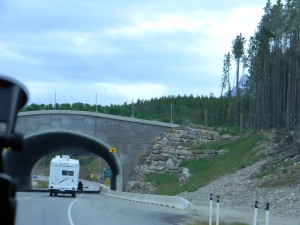This summer I visited Banff National Park in Alberta, Canada and we spent a lot of time driving on the Trans-Canada Highway. All along the TCH in Banff National Park, there are wildlife overpasses and underpasses that allow wildlife to safely cross the road without risking collision with vehicles on the road. I took a picture of one of the two overpasses currently in the park (it’s a little blurry). Having learned about habitat fragmentation and the importance of corridors in other classes, I decided to look more into this specific case.
The purpose of wildlife underpasses and overpasses is not only to protect the animals from the immediate risk of road mortality caused by park infrastructure, but also to help maintain a stable and diverse wildlife population. Because the Trans-Canada Highway is so large and heavily used, it has become a huge barrier for wildlife, which restricts their movement and habitat area, and eventually leads to a less diverse population because they are confined to a smaller habitat patch, and eventually can lead to extinction. Road mortality can also have an effect on a species’ population in a shorter amount of time (1-2 generations) than edge effects caused by the road. The project created is called The Banff Wildlife Crossings Project and was started in 1996.
In Banff National Park, they have created various measures of wildlife crossing structures in order to attempt to solve this problem. There are two wildlife overpasses that span 50-m wide over the highway. They monitored the effects of these wildlife over and underpasses for five years. From this they discovered that they have reduced all road-kill by 80%. As to determine the effect of the over and underpasses on reducing habitat fragmentation, a longer-term study is needed. However, overall the project has been a success.


I have actually also got the pleasure to see these wildlife crossings in person as well. I believe that the picture here does not give justice to how large the crossings are. While helping prevent animal deaths, they also have a lot of aesthetic value because of the large scale of their construction. According to the Road Kill Data as a part of the National Science Foundation, over 400 million animals die each year in the United States. In addition, over 200 people die each year from animal collisions in the United States. I think that this is a great idea for places that might suffer from ecological fragmentation. In the United States, scientists are using remote sensing data to figure out road-kill hot spots. A specific case study for this situation would be in Florida where the Transportation Department is constructing underpasses at dozens of these locations so that black bears, panthers, tree frogs, turtles can make safer crossings.
There is no denying that wildlife crossings such as these in Banff are beneficial and a worthwhile investment. When reading this summary, I thought of two (potentially difficult to answer) sets of questions. First, does the noise of the road prevent some species from using the crossing? If animals have grown accustomed to avoiding roads for the most part, might they still avoid these areas now, even if the crossing is available? These questions definitely pose a topic for future study. Second, how easily could larger, more urbanized areas construct these crossings, and would they work in those areas? It appears that animals will use crossings in national parks, but would crossings in urbanized areas achieve similar results, even if studies had been performed prior to their construction? Nonetheless, wildlife crossings are an exciting development in the field of wildlife conservation, and I hope that national parks in the U.S. will begin to implement them.
It would be interesting to track some of these animals and see how often they cross the highway. For example, if you set up a tracking device on a few animals, you could then use GPS and plot on a map their route for a period of time. This would track how often the wildlife overpasses are used. Also, it could track if animals find these overpasses easily, or if they walk along the raods until eventually finding an overpass.